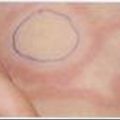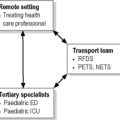7.6 Ingested foreign bodies
Introduction
Ingestion of foreign (non-food) material is common in early childhood and often goes undetected whilst the child is playing and may not prompt a physician visit. The exact frequency of reported foreign body ingestions is uncertain. The literature in this field can be divided into three areas: descriptive studies of fairly large numbers of ingestion cases; studies primarily or exclusively about coin ingestion; and studies about disc batteries.1 Common foreign bodies ingested that come to medical attention include coins, bones (fish, chicken), other metallic objects (pins, screws, keys, batteries), and plastic and rubber foreign bodies. In one large series of 1265 reported cases of foreign-body ingestions, age ranged from 7 months to 16 years with a mean of 5.2 years.2 Most foreign bodies pass through the gastrointestinal tract without complications. The emergency physician should be aware of the few instances when emergent or semi-urgent intervention is indicated. Parents need to have clear guidelines regarding the treatment plan for children who are discharged to outpatient follow up.
History
The symptoms experienced by the child since ingestion help determine the likely site of the foreign body but this has limitations. Many children are asymptomatic at presentation, which usually (but not always) suggests that the foreign body is lying in the stomach or more distal part of the gastrointestinal tract. Symptoms of vomiting, pain or discomfort on swallowing, drooling, irritability and refusal to take food or fluids may occur and suggest oesophageal foreign body. Several reports note that some children will be asymptomatic with foreign bodies lodged in the oesophagus, especially the distal oesophagus.3,4 Even in the context of sharp fishbones, a prospective study found that symptoms were a poor predictor of the presence of fishbones, except for a sharp pricking sensation on swallowing.5 Reports of abdominal pain or blood in the bowel motions should be noted. A history of previous oesophageal or other gastrointestinal disease is significant in determining a management plan and alerting one to potential complications. Significant developmental/intellectual delay has been associated with major morbidity and mortality after foreign body ingestion.2,6 This is often due to the vague symptomatology and delay in presentation.
Investigations
All children with a history of ingestion of coins or batteries (or other radio-opaque foreign bodies) should have an X-ray performed to localise the foreign body. There is some controversy on this issue in relation to the need for X-rays in children who have ingested coins. Some authors (mainly hospital-based) note that even previously healthy children can be asymptomatic with an oesophageal coin and advocate early removal of oesophageal coins to prevent serious sequelae.3,4 Other authors (notably in primary care) believe that routine X-rays in children having ingested a coin are unnecessary given that asymptomatic coin ingestion is rarely, if ever, associated with complications in otherwise healthy children.7 It has been recognised that those patients presenting to an emergency department (ED) are a selected group and would be expected to have greater severity of symptoms and higher frequency of complications.8 Hence the recommendation that all children with a history of coin ingestion who attend an ED, should have X-ray localisation of the coin performed. An alternative approach for coin ingestions is the use of a handheld metal detector for localisation of the coin. Several authors have confirmed the safety of this approach following a clear algorithm. Handheld metal detectors are not reliable at detecting metal foreign bodies other than coins.9,10 If the ingestion is unwitnessed and the object looks like a coin on anteroposterior X-ray, be aware that a disc battery may have a similar appearance. In this situation, an additional lateral view will reveal an asymmetry, as the two sides of the disc battery have slightly different diameters. On the anteroposterior view one may also see the ‘double ring’ of both circumferences of the battery.
Treatment
Coins
Coins that reach the stomach almost always pass through the gastrointestinal tract without incident and further management is unnecessary unless symptoms arise. Coins that lodge in the oesophagus and have been unrecognised can cause complications such as oesophageal perforation, mediastinitis, acquired tracheo-oesophageal or aorto-oesophageal fistula formation – and death has been reported.11 All children who are symptomatic should have a procedure to remove the coin. Asymptomatic children with proximal or middle-oesophageal coins should also have the coin removed as it is unlikely to pass spontaneously (20–30% in one series).3 If there is a significant delay before the procedure (of more than a few hours) the X-ray should be repeated to ensure that spontaneous passage into the stomach has not occurred or a metal detector should be used to check if the position has clearly changed. Asymptomatic children with distal oesophageal coins can safely be observed as outpatients (depending on social circumstances) for 12–24 hours. The chance of spontaneous passage into the stomach has been reported to occur in 37–60% of patients.3,4
Disc batteries
Disc batteries are used for hearing aids, electronic devices and children’s toys and cause tissue destruction due to their alkaline nature when in contact with moist membranes. Two deaths have been reported in the literature in situations of oesophageal batteries in children with delayed presentations.12 Children with a history of possible ingestion of a disc battery should have an urgent X-ray performed. If the battery is lodged in the oesophagus, removal should be performed on an emergent basis because mucosal injury can occur in a few hours. Litovitz and Schmitz studied 2382 cases of battery ingestion over 7 years (97% were disc batteries) which were reported to a national registry.13 There were only two major adverse outcomes, both occurring in children with oesophageal batteries. There were no deaths. There were 16 children with oesophageal disc batteries. In 88.3% the battery passed through the gastrointestinal tract with no symptoms or minor symptoms only. In 8.4% there were unrelated or unknown symptoms. As few as 3.1% of patients suffered moderate symptoms (defined as more pronounced or multiple episodes of nausea, vomiting, fever, bloody stools or emesis or changes in vital signs). Forty-four patients had arrested transit defined as identical non-oesophageal site on successive X-rays 48 hours apart: 17 in stomach; two in small intestine; 16 in the colon; and in nine at unidentified sites. Although more patients had minor or moderate symptoms in this group, none had major adverse effects. Outcome was more severe when there was arrested transit in the stomach. Battery transit time was known for 1366 patients. For the great majority (86.4%) the battery passed through the gastrointestinal tract in 96 hours.
1 Brown L., Dannenberg B. A literature-based approach to the identification and management of paediatric foreign bodies. Pediatr Emerg Med Rep. 2002;7:19.
2 Cheng W., Tam P.K.H. Foreign body ingestion in children: experience with 1265 cases. J Pediatr Surg. 1999;34:1472-1476.
3 Soprano J.V., Fleisher G.R., Mandl K.D. The spontaneous passage of esophageal coins in children. Arch Pediatr Adolesc Med. 1999;153:1073-1076.
4 Connors G.P., Chamberlain J.M., Ochsenschlager D.W. Symptoms and spontaneous passage of esophageal coins. Arch Pediatr Adolesc Med. 1995;149:36-39.
5 Ngan J.H., Fok P.J., Lai E.C., et al. A prospective study on fishbone ingestion. Experience of 358 patients. Ann Surg. 1990;211:459-462.
6 Gilchrist B.F., Valerie E.P., Nguyen M., et al. Pearls and perils in the management of prolonged, peculiar penetrating esophageal foreign bodies in children. J Pediatr Surg. 1977;32:1429-1431.
7 Connors G.P., Chamberlain J.M., Weiner P.R. Paediatric coin ingestion: a home based survey. Am J Emerg Med. 1995;13:638-640.
8 Paul R.I., Christoffel K.K., Binns H.J., et al. Foreign body ingestions in children: risk of complication varies with site of initial health care contact. Paediatrics. 1993;91:121-127.
9 Seikel K., Primm P.A., Elizondo B.J., et al. Handheld metal detector localisation of ingested metallic foreign bodies. Arch Pediatr Adolesc Med. 1999;153:853-857.
10 Lee J.B., Ahmad S., Gale C.P. Detection of coins ingested by children using a handheld metal detector: a systematic review. Emerg Med J. 2005;22:839-844.
11 Byard R.W., Moore L., Bourne A.J. Sudden and unexpected death: a late effect of occult intraesophageal foreign body. Pediatr Pathol. 1990;10:837-841.
12 Blatnik D.S., Toohill R.J., Lehman R.H. Fatal complication from an alkaline battery foreign body in the esophagus. Ann Otol Rhinol Laryngol. 1977;86:611-615.
13 Litovitz T., Schmitz B.F. Ingestion of cylindrical and button batteries: an analysis of 2382 cases. Paediatrics. 1992;89:747-757.




